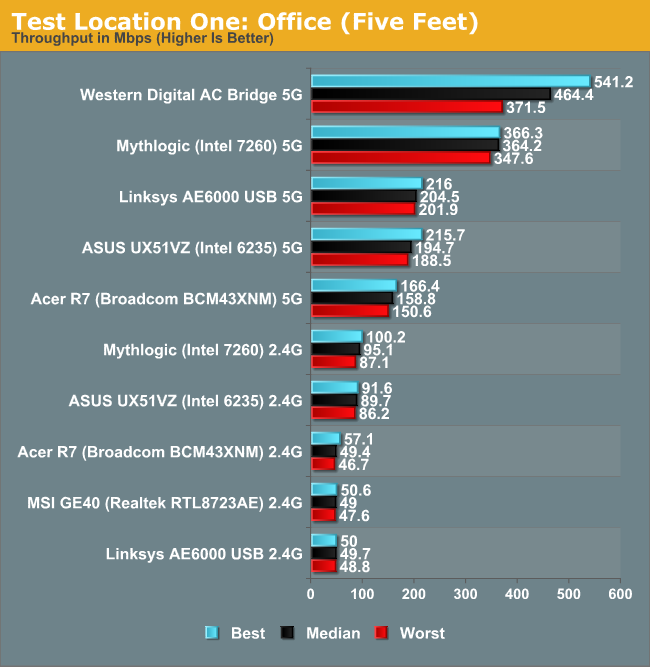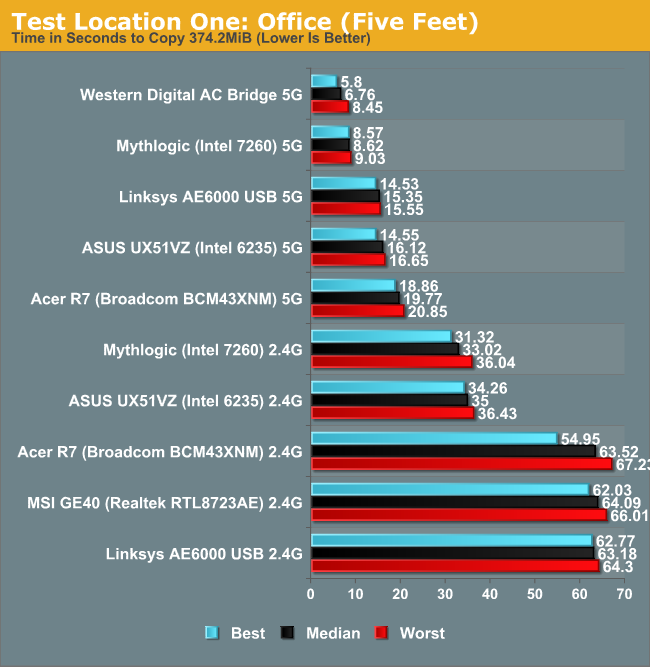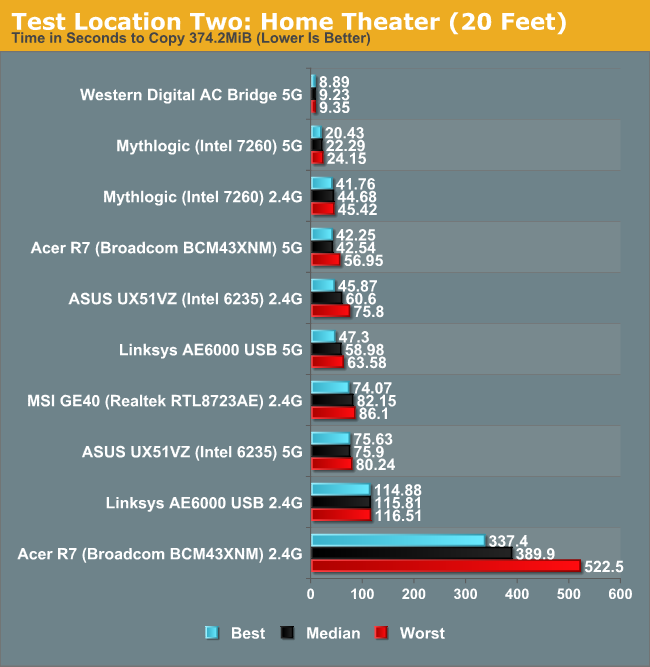The Joys of 802.11ac WiFi
by Jarred Walton on July 8, 2013 8:15 PM ESTA Quick Test of Real-World Wireless Performance
For testing, I grabbed a bunch of the hardware I had around and gathered one set of numbers: average throughput copying a single large file from my desktop with a wired Gigabit Ethernet connection to a laptop. I’m using Western Digital’s MyNet AC1300 router as the wireless router. The AC1300 is running firmware v1.03.09, and it's a product that has now been around for eight or so months. It supports up to 450Mbps (3x3:3 MIMO) on 802.11n connections and up to 1300Mbps on 5GHz 11ac connections. (Unfortunately, I didn't ever seem to connect with more than two 11ac streams with my current hardware, including Western Digital's AC Bridge.) We’re still not at Gigabit Ethernet speeds in most cases, but with nearly triple the throughput of the fastest 11n wireless it’s definitely getting closer.
For the adapters, I tested both single- and dual-band offerings. On the 802.11ac side, I used an 11ac bridge (the Western Digital My Net AC Bridge), a USB 11ac adapter (Linksys AE6000), and a Clevo P157SM notebook from Mythlogic (Pollux 1613) equipped with Intel’s latest Wireless-AC 7260 adapter. I should take a minute to note that one of the great things about going with a boutique laptop vendor like Mythlogic is the ability to customize not just the storage and CPU, but the WiFi adapter as well. Then I tossed in three other laptops, two of which I’m working on reviewing along with a previously reviewed laptop. The ASUS UX51VZ uses Intel’s common Wireless-N 6235 adapter (dual-band 2x2:2 MIMO with Bluetooth 4.0), Acer’s Aspire R7-571-6468 “oversized hybrid” uses a Broadcom BCM43XNM chipset (based on the hardware ID, it appears to be the BCM943228HM4L, or at least something similar—it’s also dual-band 2x2:2 MIMO with Bluetooth 4.0 support), and the MSI GE40 is the lone 2.4GHz single-band 150Mbps offering sporting a Realtek RTL8723AE chipset. All of the adapters were tested in both 2.4GHz and 5GHz modes (where applicable).
And with that said, here are the results from two test locations. Location one is with the target device in the same room as the router (my office), about five feet away. The second location is downstairs at the home theater area (my “second office”), about 20 feet away with one wall and one floor in between. The results show minimum, median, and maximum throughput of five test runs, with the caveat that I made sure there were no outliers—sometimes Windows or WiFi will have a really slow run or two.


Not surprisingly, the AC Bridge posts the best performance of all the solutions. With three spatial streams, I was hoping to get a lot closer to 800-900Mbps of throughput, but most of the time it appears to have run at closer to two streams. Performance isn't all that different from the Mythlogic laptop with Intel’s 7260 AC adapter at the short range location, but it’s over twice the speed at the second test location. What’s even worse is how poorly many of the solutions end up performing at the second test location.
I’m not surprised to see the Mythlogic notebook post excellent throughput over 5GHz 802.11ac, but it ends up being the third fastest solution even when falling back to 2.4GHz 802.11n at the second location! I could live with throughput of 50+ Mbps throughout my home, but pulling over 300Mbps from the downstairs HTPC to my other networked PCs over wireless is simply awesome…as long as the wireless signal doesn’t get dropped.
I haven’t actually had that happen with the Western Digital AC1300 (yet), but over the past seven or so years of testing notebooks and laptops for AnandTech, dropped wireless connections are a far too common occurrence in my experience. I’ve been through about ten wireless routers during that time, and even the best were never quite as stable/dependable as wired Ethernet. Some might go a couple weeks or even a month without needing a reboot (e.g. the Amped Wireless), while others might have WiFi "crash" every couple of days.
Throw in the lackluster WiFi adapters you find in most laptops (represented here by the Realtek RTL8723AE) and you can hopefully understand why having Gigabit Ethernet in notebooks still matters to a lot of people. I've got a second set of graphs that shows the same data as above, only in seconds required rather than Mbps:


Our current mobile test suite at present weighs in at a hefty 121GiB; over Gigabit Ethernet it takes about 20 minutes to copy everything over. Now imagine a laptop like the MSI GE40, except without the Ethernet port, and I’d be looking at nearly six hours just to copy the testing files over WiFi. (Thank goodness for USB 3.0 external SSD adapters!) But perhaps you never bother with copying large amounts of files over your local network, so slower WiFi speeds aren’t such an issue, right? My Comcast Internet now tops out with downstream speeds of up to 40Mbps and upstream rates of 12Mbps; when I’m not in my office, that means some of the adapters/laptops out there are likely going to bottleneck my Internet speed. It’s not the end of the world when you can only get 25Mbps, but there are certainly times when you’ll notice the difference—particularly if you have multiple PCs accessing the net concurrently.
One final item to discuss is that the adapters aren’t the whole story. You can see in the charts above that just because something supports two spatial streams on WiFi doesn’t inherently mean better performance than single stream adapters. The tiny USB WiFi adapter only manages average performance on a 5GHz connection from a couple rooms away from the router, and on a 2.4GHz connection it ends up being the slowest option outside of the Acer R7 2.4GHz result. Better antennas matter, and in the case of the Acer R7, the tuning of the antenna is likely another major factor.
The R7 actually fails to detect my 2.4GHz network from 50 feet away, yet it still manages to connect to the 5GHz network, and the R7 isn’t alone in such funky behavior. I’ve had laptops where the WiFi adapter powers off when the system has been running more than about 48 hours straight (even if the WiFi wasn’t doing anything), and the only way to get it back is to turn the adapter off and then turn it back on. And if laptops can sometimes have flaky WiFi implementations, many of the tablets out there are worse—range on two of my Android tablets is probably 50 feet at best before I have problems, so even my driveway is “too far” to get WiFi coverage.










139 Comments
View All Comments
Sylvala - Friday, July 19, 2013 - link
Apple implentation is the best? lol http://arstechnica.com/apple/2013/07/apple-patches...JarredWalton - Sunday, July 21, 2013 - link
Don't mistake the Air problems with Apple issues in general. Apples WiFi in the past has been far better on most laptops, at least on the MacBook Pro line. They've had dual-band 3x3:3 with two chipsets in their AirPort Extreme for many years now, and the result has been very good performance.phoenix_rizzen - Monday, July 22, 2013 - link
In the comprehensive review, would it be possible to test combined throughput for multiple clients connected to the same AP?While it's great to benchmark/measure the throughput a single client connected to a single AP can achieve, that's not very realistic compared to how wireless is actually used, even in single-family homes. It's very rare you'll see a single device connected to an AP, what with the proliferation of phones, tablets, laptops, and consoles in homes these days. And workplaces are even worse.
Perhaps as a final benchmark, you could run the download test on every laptop simultaneously and measure the overall throughput from the AP? Would be interesting to see how each AP handles that situation.
JarredWalton - Monday, July 22, 2013 - link
I can certainly try that; usually, though, what you get is a high burst of traffic from one client for a bit, then another high burst, etc. If you are running a file server with lots of wireless clients, you'd really want to go with distributed access points most likely -- unless you're in a small area, and then a single AP might be sufficient.agrntn - Sunday, September 1, 2013 - link
What is '802.11'?uio77 - Saturday, December 28, 2013 - link
Hello wireless gurus:I just got one of this WD my net bridge AC adapter and connected to the 5G band to a Netgear Nighthawk. To measure how fast the transfer speed is I copied a file from my NAS to my desktop and the speed do not pass 4mbps. I tried changing setting in the router but no luck. The setting in the bridge are almost none. Do any of you have an idea in why this think is given me such a lame speed over AC, Thanks guys
mshirley1964 - Monday, April 20, 2015 - link
I recently upgraded to comcast's x1 platform and it came with a dual band router.I just got an 802.11ac usb wifi adapter for my laptop and just check out the before
and after results:
http://productresearch.info/802-11ac-speed-demon-n...
mshirley1964 - Monday, April 20, 2015 - link
I recently upgraded to comcast's x1 platform and it came with a dual band router.I just got an 802.11ac usb wifi adapter for my laptop and just check out the before
and after results:
http://productresearch.info/802-11ac-speed-demon-n...
Aint that amazing?!
Mike-
Barney4 - Tuesday, August 11, 2015 - link
I don't know why others have had problems, but I have had mine running non-stop (apart from electrical blackouts of course) since new.That is over 5 years now!
Not one disconnection or problem - EVER!!
We have a old federation double brick house, so that causes a little distance problem, but it still gets a signal through 3 walls for a distance of about 50 feet (depending on the connecting device) before losing the signal.
With only one obstructing wall we get somewhere between 50 to about 75 feet depending on the connecting device.
I must admit to changing the antennae to a better one (a 9dB) which has given it a much more consistent and stronger signal at distance.
All I have done is plug it in, set it up and never touched it since.
I am also running 3x different Uniden cordless phone systems (900mHz, 2.4GHZ and 5GHz), recently I have 2x TV's and 2x computers plus 3x mobile phones which use widi. None of this causes any interference.
Can not figure out why so many people have had their router"s cause problems, could be some sort of interference problem, maybe even the external devices used, because the Netcomm NP804N has worked just as it is supposed to. And flawlessly!